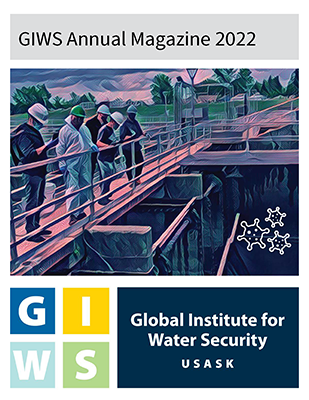Water Publications at USask
Select Reports
The GIWS Progress Reports outline the collective progress of the institute and our members and highlight research accomplishments.
The institute contributed to a November 2015 special issue of the Journal of Great Lakes Research that showed what happens upstream has the most impact on the reservoir’s water quality. Of the 15 articles in the special issue, GIWS contributed 13 papers studying the physical, chemical and biological properties of Lake Diefenbaker and assessing the reservoir’s susceptibility to increasing stress.
A report by the University of Saskatchewan Global Institute for Water Security (GIWS) presents the first comprehensive survey of the state of groundwater and hydrogeological research in Saskatchewan and outlines the steps required to develop and protect this resource.
The report, titled Groundwater, Hydrogeology and Sustainability in Saskatchewan was commissioned by GIWS and written by Denis Peach, retired chief scientist with the British Geological Survey, and based on extensive consultations with government, industry and academic sectors in Saskatchewan. The report contains a series of key recommendations to gain an understanding of the state of groundwater research in the province and how to move it forward.
As part of our GIWS socio-hydrology research theme, the Downstream play used a novel approach to communicate research results to stakeholders. Performances took place throughout Saskatchewan and Alberta during February 2014.
The play conveyed dramatized perspectives of water security in the Saskatchewan River Basin and was a collaboration with the U of S Drama Department. Audience members participated throughout the performance and a focus group of decision makers followed the play.
In 1997, after the devastating Assiniboine River flood of 1995, a research effort was started to better understand and model Canadian Prairie hydrology with an emphasis on snowmelt derived flooding and the role of depressional storage in controlling the contribution of basin runoff to streamflow. This effort led to a hydrological model suitable for prairie applications including the impact of wetland drainage and restoration.
Centre for Hydrology Report No. 14, Improving and Testing the Prairie Hydrological Model at Smith Creek Research Basin has now been published, describing the results a multi-year study to better simulate the hydrology of a Saskatchewan prairie watershed with the Cold Regions Hydrological Model and then use the model to evaluate the hydrological function of depressional storage in the Canadian Prairies
Howard Wheater, GIWS director and Canada Excellence Research Chair in Water Security, chaired the Council of Canadian Academies panel on water and agriculture in Canada, which released its final report in February 2013.

